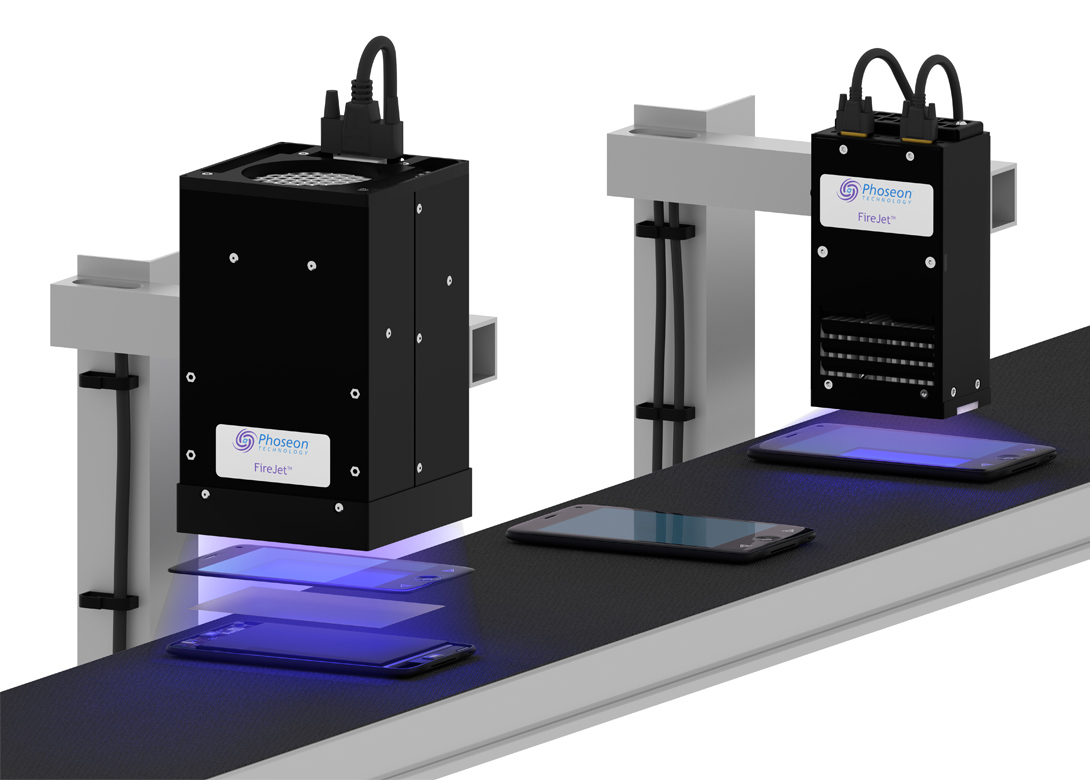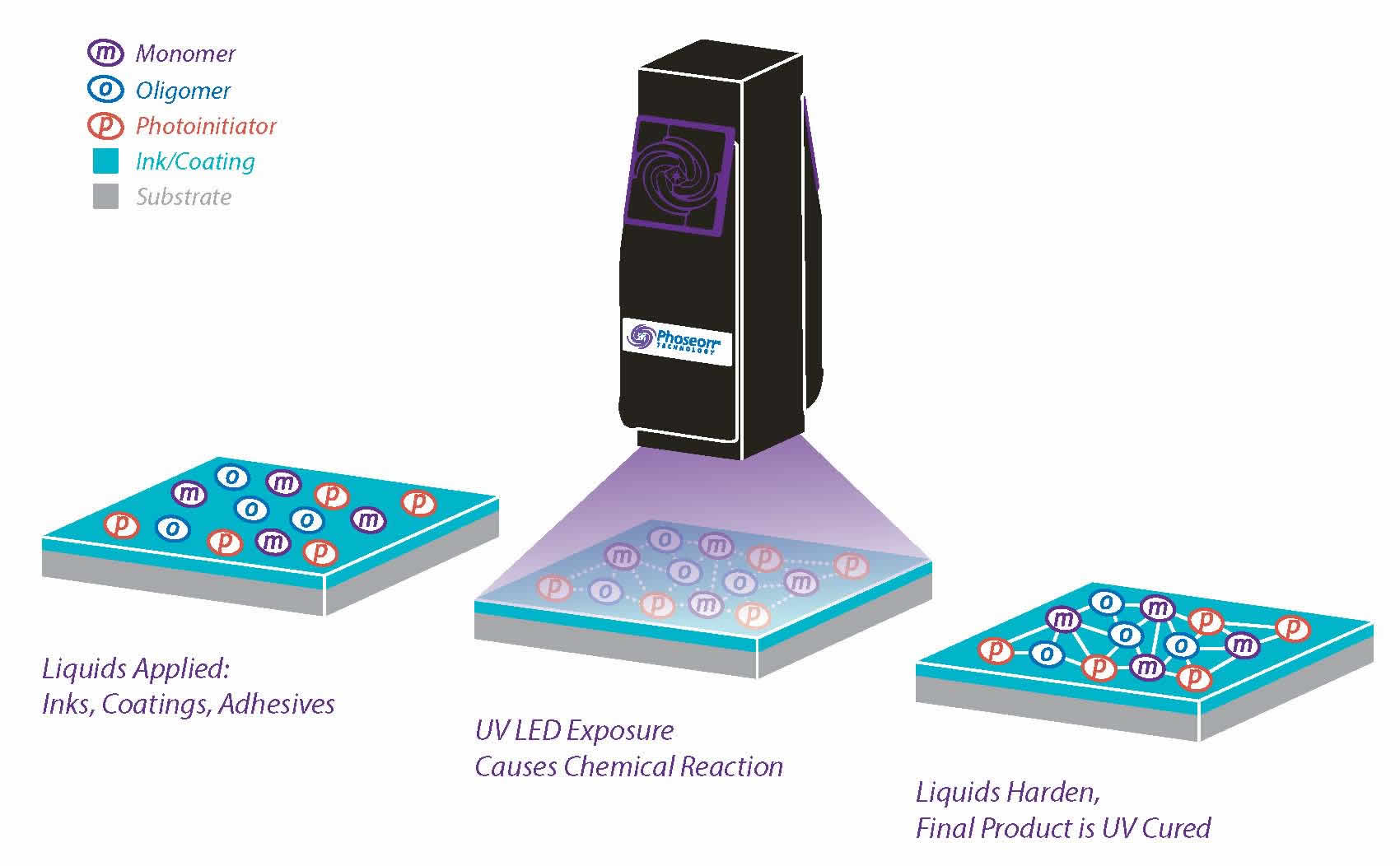
When looking to improve yield rates through higher productivity and reduced scrap, manufacturers should consider UV LED curing technology. Here, Phoseon Technology looks at the formulations available for use with UV LED curing that are easy to handle and apply in the precision, high-speed processes that are so common in manufacturing.
UV LED curing offers manufacturers higher yield rates and productivity due to a consistent and stable process with less damage to heat-sensitive components. In addition, UV LEDs are highly efficient offering significant energy cost savings. They require very little space, making them easy to integrate into small spaces. Since UV LEDs produce no ozone emissions or hazardous waste concerns, they are an environmentally friendly and safe UV curing technology.
Adhesive bonding, sealing, and coating processes in factory assembly lines are rapidly upgrading to UV LED curing technology because of all the advantages. UV LED technology offers lower operating costs, longer lifetime, enhanced system capabilities, and environmental benefits compared to traditional mercury UV curing.
Application segments
UV adhesive curing application segments include electronic assembly, automotive, medical, ammunitions, pressure sensitive films, general assembly, and other manufacturing processes.
UV LED curing technology is ideally suited for electronic assembly applications. The combination of high energy UV LED sources with the appropriate adhesive enables increased productivity while also providing the ability to cure heat sensitive materials. Today, many electronics manufacturers use UV LED curing in the production of products such as touchscreens, mobile phones, micro-speakers, and hard disk drives.
Adhesives used in medical applications, such as syringes, catheters, IV delivery systems, endoscopes, and hearing aids, often benefit from UV curing technology. Properties such as better uniformity, low heat, instant on/off, and long lifetime are ideal for this highly regulated industry.
In automotive coating applications, UV LED provides near instant curing of functional and decorative coatings. The lightweight materials used in today’s automobiles benefit from the low temperature of UV LED technology. The automotive industry uses UV LED curing solutions for forward lighting, tail lenses, interior and exterior trim components, and body panels.
UV LED curing solutions are used in ammunition production for waterproofing, adhesive bonding, sealing, and coating. The UV LED curing of external ammunition sealants can make bullet pull strength more consistent, thereby improving performance and accuracy. Examples of ammunitions-related applications include external ammunition sealing (i.e., waterproofing); igniter, fuse, and detonator UV sealing; specialty UV coatings and primers; blank ammunition sealing; shot shell crimp sealing; and tip colour coding.
General assembly, industrial grade bonding processes require products that can work in tough, sometimes harsh manufacturing environments. Industrial UV LED curing applications include EV batteries, solar panels, wood/plastic coatings, thin films, bottle processing, aviation, automobiles, and many others.
Understanding UV curing
 UV curing is a photopolymerisation process that uses UV energy to change a liquid to a solid. Upon absorption of the UV energy, the photo initiator (PI) produces free radicals that initiate crosslinking with binders (monomers and oligomers) in a polymerisation reaction to cure or solidify the coating or adhesive, usually in a few seconds.
UV curing is a photopolymerisation process that uses UV energy to change a liquid to a solid. Upon absorption of the UV energy, the photo initiator (PI) produces free radicals that initiate crosslinking with binders (monomers and oligomers) in a polymerisation reaction to cure or solidify the coating or adhesive, usually in a few seconds.
Industrial sources of UV energy have long included medium-pressure mercury arc and microwave-powered lamps, as well as the more recent LEDs. All three technologies are used to crosslink inks, coatings, and adhesives in a wide range of manufacturing processes. Both arc and microwave curing technologies rely on the vaporisation of mercury within a sealed quartz tube containing an inert gas mixture. Mercury lamps require toxic mercury disposal and produce ozone gas that needs to be extracted by ventilation.
UV LEDs are solid state semiconductors. UV LED generates UV energy by applying an electric current to a semiconductor device called a diode, causing it to emit UV energy. The specific materials in the diode determine the wavelengths of the output, which is typically in a very narrow band ±10Nm. UV LED light sources are provided in single wavelength configurations, typically centered on a specific wavelength, ±5Nm. This near monochromatic distribution requires new chemical formulations to ensure proper curing of adhesives and coatings.
To achieve efficient and effective UV curing of an adhesive or coating, the formulator seeks to match the UV lamp spectral output with the absorption characteristics of the photoinitiators used in the formulation. Since current generation UV LED emission wavelengths are strongest at 365Nm and 395Nm, photoinitiators and other formulation components should be selected to allow efficient excitation of the photoinitiators at those wavelengths.

Reliability and long lifetime
If architected correctly, LED light sources can have exceptionally long lives. LED technology minimises the heat load to the work surface, allowing for capability with heat sensitive applications. The long lifetime, instant on/off control, and consistent UV output can improve process variation and control. Similar to the lighting industry, LED curing technology has been proven to be extremely reliable.
Even though LED technology is reliable, it is important to keep in mind that LED light sources are not created equally. Suppliers have significant architectural and implementation decisions that impact their products’ performance. The ideal end result will be a LED curing system with optimised LEDs, arrays, optics, and cooling for a specific application. Knowing how to characterise the performance allows the user to identify the best overall system to meet their needs.
While traditional mercury lamps may last up to 3,000 hours, properly managed LEDs will last over 60,000 hours. If the light sources are not cooled properly, however, they will have a much shorter lifetime and will be less reliable. Before choosing an LED supplier, ask for data on the lifetime of their lamps to make sure they are proven to be reliable.
Phoseon’s UV LED curing systems are successfully curing inks, coatings, and adhesives in many demanding applications worldwide.
www.phoseon.com

Having spent a decade in the fastener industry experiencing every facet – from steel mills, fastener manufacturers, wholesalers, distributors, as well as machinery builders and plating + coating companies, Claire has developed an in-depth knowledge of all things fasteners.
Alongside visiting numerous companies, exhibitions and conferences around the world, Claire has also interviewed high profile figures – focusing on key topics impacting the sector and making sure readers stay up to date with the latest developments within the industry.





